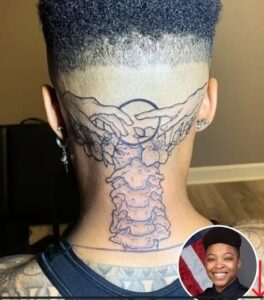Kay’Ana Adams Speaks Out After Being Fired Over Tattoo

In Alabama, a young firefighter’s dismissal has sparked a nationwide conversation about self-expression, workplace fairness, and hidden inequities. Kay’Ana Adams says she lost the job she loved over a tattoo — a decision she believes reveals much deeper problems within the system.
Kay’Ana joined the Mobile Fire Department with pride and purpose, determined to serve her community. Becoming a firefighter had been a lifelong dream, and just nine months into her service, she felt she was exactly where she belonged. That changed abruptly when she was terminated because of a tattoo on the back of her head — a tattoo she had chosen in June 2022 to mark her triumph over scoliosis, a spinal condition she’d battled since childhood. To her, the design symbolized perseverance, bravery, and a refusal to give up, no matter the odds.
When she got the tattoo, department policy prohibited only face and neck tattoos. She made sure hers followed the rules and even kept her hair long enough to ensure it stayed hidden while she was on duty.
Everything shifted after a colleague filed a complaint about her tattoo. Instead of resolving the matter directly, the department changed its rules to ban all tattoos on the head, visible or not. On November 10, 2023, a captain photographed her tattoo while her hair was up — just hours later, she was fired.
The decision blindsided her. She believed she had respected both the original guidelines and the new policy. But she also suspected other factors were at play. Earlier in her employment, Kay’Ana had filed formal complaints about a hostile work environment, including sexist remarks and disturbing jokes about nooses during training. Speaking up, she feared, had placed her at odds with influential figures in the department.
Her termination wasn’t the only fallout. Two captains who supported her — Jason Craig and Rodrick Shoots — also faced harsh repercussions: one suspended, the other dismissed. Official explanations cited insubordination and policy breaches, but many believe these were thinly veiled acts of retaliation.
The incident has reignited debate over personal appearance standards in public service. Critics point out that rigid bans on tattoos can disproportionately affect people of color, individuals with certain hair types, and those with cultural or personal markings. For Kay’Ana, her tattoo was not a fashion statement but a powerful emblem of survival. Having it used as justification for her firing felt like an attack on her identity.
Her story forces a broader discussion: At what point do appearance policies cross into discrimination? Does “professionalism” sometimes serve as a cover for silencing voices that challenge the status quo? And who gets to decide what is acceptable in a modern workplace?
Today, Kay’Ana’s fight is no longer just about a tattoo. It’s about dignity, diversity, and the right to be valued for one’s skills and character rather than surface-level conformity. By speaking out, she has become a symbol of the ongoing struggle for equity and authenticity in professional environments — and a reminder that real fairness demands more than just words.